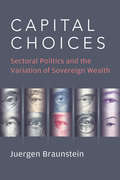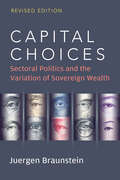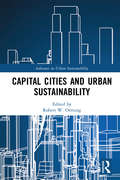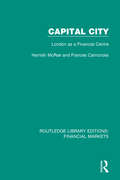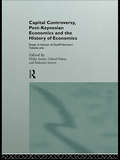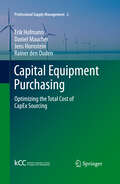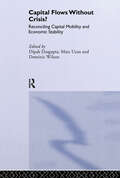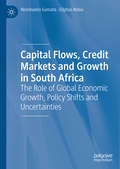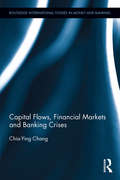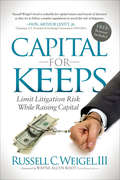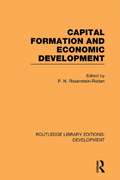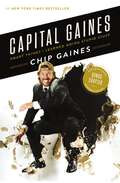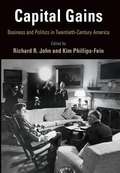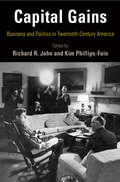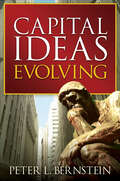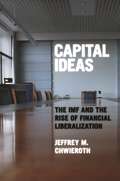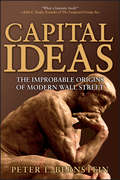- Table View
- List View
Capital Choices: Sectoral Politics and the Variation of Sovereign Wealth
by Juergen BraunsteinSovereign wealth funds are state-controlled pools of capital that hold financial and real assets, including shares of state enterprises, and manage them to grow the nation’s base of sovereign wealth. The dramatic rise of sovereign wealth funds (SWFs) in both number and size—this group is now larger than the size of global private equity and hedge funds, combined—and the fact that most are located in non-OECD countries, has raised concern about the direction of capitalism. Yet SWFs are not a homogenous group of actors. Why do some countries with large current account surpluses, notably China, create SWFs while others, such as Switzerland and Germany, do not? Why do other countries with no macroeconomic justification, such as Senegal and Turkey, create SWFs? And why do countries with similar macroeconomic features, such as Kuwait and Qatar or Singapore and Hong Kong, choose different types of SWFs? Capital Choices analyzes the creation of different SWFs from a comparative political economy perspective, arguing that different state-society structures at the sectoral level are the drivers for SWF variation. Juergen Braunstein focuses on the early formation period of SWFs, a critical but little understood area given the high levels of political sensitivity and lack of transparency that surround SWF creation. Braunstein’s novel analytical framework provides practical lessons for the business and finance organizations and policymakers of countries that have created, or are planning to create, SWFs.
Capital Choices: Sectoral Politics and the Variation of Sovereign Wealth
by Juergen BraunsteinSovereign wealth funds are state-controlled pools of capital that hold financial and real assets, including shares of state enterprises, and manage them to grow the nation’s base of sovereign wealth. The dramatic rise of sovereign wealth funds (SWFs) in both number and size—this group is now larger than the size of global private equity and hedge funds, combined—and the fact that most are located in non-OECD countries, has raised concern about the direction of capitalism. Yet SWFs are not a homogenous group of actors. Why do some countries with large current account surpluses, notably China, create SWFs while others, such as Switzerland and Germany, do not? Why do other countries with no macroeconomic justification, such as Senegal and Turkey, create SWFs? And why do countries with similar macroeconomic features, such as Kuwait and Qatar or Singapore and Hong Kong, choose different types of SWFs? Capital Choices analyzes the creation of different SWFs from a comparative political economy perspective, arguing that different state-society structures at the sectoral level are the drivers for SWF variation. Juergen Braunstein focuses on the early formation period of SWFs, a critical but little understood area given the high levels of political sensitivity and lack of transparency that surround SWF creation. Braunstein’s novel analytical framework provides practical lessons for the business and finance organizations and policymakers of countries that have created, or are planning to create, SWFs.
Capital Choices: Sectoral Politics and the Variation of Sovereign Wealth
by Juergen BraunsteinSovereign wealth funds are state-controlled pools of capital that hold financial and real assets, including shares of state enterprises, and manage them to grow the nation’s base of sovereign wealth. The dramatic rise of sovereign wealth funds (SWFs) in both number and size—this group is now larger than the size of global private equity and hedge funds, combined—and the fact that most are located in non-OECD countries, has raised concern about the direction of capitalism. Yet SWFs are not a homogenous group of actors. Why do some countries with large current account surpluses, notably China, create SWFs while others, such as Switzerland and Germany, do not? Why do other countries with no macroeconomic justification, such as Senegal and Turkey, create SWFs? And why do countries with similar macroeconomic features, such as Kuwait and Qatar or Singapore and Hong Kong, choose different types of SWFs? Capital Choices analyzes the creation of different SWFs from a comparative political economy perspective, arguing that different state-society structures at the sectoral level are the drivers for SWF variation. Juergen Braunstein focuses on the early formation period of SWFs, a critical but little understood area given the high levels of political sensitivity and lack of transparency that surround SWF creation. Braunstein’s novel analytical framework provides practical lessons for the business and finance organizations and policymakers of countries that have created, or are planning to create, SWFs.
Capital Cities and Urban Sustainability (Advances in Urban Sustainability)
by Robert W. OrttungCapital Cities and Urban Sustainability examines how capital cities use their unique hub resources to develop and disseminate innovative policy solutions to promote sustainability. Cities are taking a leading role in defining a sustainable future at a time when national, state, and regional governments in several countries do not provide sufficient leadership. Capital cities stand out among cities as likely leading drivers in the effort to empower sustainable innovation as they provide a hub for connecting a variety of key constituencies. While acknowledging the successes capital cities have achieved, the international, multi-disciplinary contributors to this work discuss how there is room to do more and improve. The promotion of specific sustainability policies in crucial areas such as clean water provision, high tech innovation, public procurement contracting, and improving flood control in capital cities is examined through various global case studies. The examples range from relatively rich capital cities, such as Copenhagen, where the well-financed hub would be expected to succeed in generating sustainable policies, to poorer cities such as Phnom Penh, where such an optimistic outcome can seem less likely.
Capital City: London as a Financial Centre (Routledge Library Editions: Financial Markets #15)
by Frances Cairncross Hamish McRaeOriginally published in 1985, Capital City: London as a Financial Centre proves in depth analytical description of the financial institutions of the City of London. The book describes in detail the operations of the banks, the stock market, the insurance world and other bodies that make up the world’s largest international financial centre. The book also answers a series of questions on the City’s performance, accountability and honesty and explains how the City reached its present position, discuss its future.
Capital Controls
by Laura Alfaro Rawi AbdelalOnly in the waning years of the 20th century did international financial markets begin to enjoy the freedom from government regulation that they had experienced before the first world war. By 2002, international capital markets had grown to be enormous--$1.2 trillion flowed around the globe per day. The massive size of the market presented policy makers with a serious challenge as they were forced to grapple with the costs and benefits of such mobile capital. This note briefly relates the modern history of capital controls and summarizes scholarship on the advantages and disadvantages of international financial market regulation.
Capital Controls and International Economic Law (Cambridge International Trade and Economic Law)
by Bryan MercurioFocusing on capital controls, this study provides rigorous legal analysis to establish whether the mandate of the International Monetary Fund (IMF) extends to the capital account; that is, whether the IMF has the authority to control and/or regulate the use of capital controls by its member states. The book then analyses whether a country's use of capital controls is consistent with the obligations and commitments undertaken in various multilateral and bilateral trade and investment agreements. Finally, it analyses the tension within international economic law, as the IMF now encourages the use of capital controls under certain circumstances, while most trade/investment agreements prohibit or limit their use. Proposing a way forward to alleviate the tension and construct a more harmonious relationship between the norms and standards of finance, trade and investment, this study will be essential reading for policymakers.
Capital Controls in Chile in the 1990s (A)
by Laura Alfaro Rafael Di Tella Ingrid VogelIn 1991, Chile adopted a framework of capital controls focused on reducing the massive flows of foreign investment coming into the country as international interest rates remained low. Capital inflows threatened the Central Bank's ability to manage the exchange rate within a crawling band, which aimed eventually to lower Chile's rate of inflation to international levels. Until the Asian financial crisis of 1997 and the Russian debt crisis of August 1998, the Chilean economy performed spectacularly under, or perhaps in spite of, these controls. In the aftermath of the Asian and Russian crises, Chile's economy began to suffer through both trade and financial channels. Chile's current account deteriorated not only because Chile relied on Asia as a market for one-third of its exports, but also as the price of cooper, Chile's largest export product, plummeted in the face of dwindling Asian demand. Financial flows to Chile, like to emerging markets in general, fell dramatically as investors panicked. By the end of 1999, Chile had experienced Latin America's most severe "sudden stop" of external capital flows. In this new economic environment, Chile was forced to reevaluate its system of capital controls. Many observers in the private sector blamed the controls for unnecessarily adding to the strain and demanded the controls be dismantled completely. Meanwhile, Chile's Central Bank continued to defend the controls and argued that they had helped insulate the country for worse contagion.
Capital Controls in Chile in the 1990s (B)
by Laura Alfaro Rafael Di Tella Ingrid VogelSupplements the (A) case.
Capital Controls: Country Experiences with Their Use and Liberalization
by Akira Ariyoshi Andrei Kirilenko Inci TkerA report from the International Monetary Fund.
Capital Controversy, Post Keynesian Economics and the History of Economic Thought: Essays in Honour of Geoff Harcourt, Volume One (Routledge Frontiers of Political Economy #Vol. 6)
by Philip Arestis Malcolm Sawyer Gabriel PalmaHarcourt has made substantial and wide-ranging contributions to economics in general, and to post Keynesian economics in particular. In this volume more than forty leading economists pay tribute to and critically evaluate his work. The contributors represent a wide range of schools in economics, and include Nobel Laureates Paul Samuelson and Robert Solow.
Capital Directive in Europe
by Dirk Van GervenThis book provides an overview of the Second Council Directive 77/91/EEC of 13 December 1976 (also known as the Capital Directive) and its implementing rules in each Member State of the European Union and the European Economic Area. It provides companies and advisors with useful insights regarding articles of association and related documents, the incorporation and capital requirements of European companies with limited liability and the rules applicable to the acquisition and pledge of their own shares, the cross-participations, the financial assistance and the distribution of profits. A general report on the Capital Directive is followed by a discussion of the implementation of the rules laid down in the Directive in the national laws of each Member State, each in accordance with a common format and contributed by a practitioner from that State.
Capital Equipment Purchasing: Optimizing the Total Cost of CapEx Sourcing (Professional Supply Management #2)
by Erik Hofmann Daniel Maucher Rainer Den Ouden Jens HornsteinCompared to other main groups of procurement, capital equipment features numerous characteristics that significantly impact the purchasing process. The process of purchasing capital equipment therefore requires specific attention and above all a systematic approach. To overcome these challenges, a holistic process model and specific tools and methods for capital equipment purchasing are presented. The following topics regarding capital equipment purchasing are presented: * Compliance management * Savings measurement * Life cycle costs and total cost of ownership * Determining the optimum useful life and replacement time * Real options approach for the evaluation of investment alternatives * Performance contracting Readers are provided with a comprehensive and structured process model for capital equipment purchasing. The comprehensive set of methods including various instruments and methods presented in this book support the establishment of a professional capital equipment purchasing process.
Capital Flows Without Crisis?: Reconciling Capital Mobility and Economic Stability (Routledge Studies in the Modern World Economy #31)
by Dipak Dasgupta Marc Uzan Dominic WilsonThe last decade has seen a massive increase in international capital flows to emerging markets. This development has offered opportunities to those countries that have opened themselves up to overseas capital, but it has also created risks.In this volume, a team of policymakers and academics from 14 different countries, as well as representatives of the international financial institutions primarily responsible for responding to the crises, examine the challenges and options facing policymakers today. The book includes both detailed analysis of individual economies from around the world and in-depth analysis of the broad systemic issues of why crises occur and how we can prevent them. By looking at economies from many different parts of the world, the book provides a broad and comprehensive look at the similarities and differences in recent financial crises.
Capital Flows in the APEC Region
by Mohsin S. KhanThe developing economies of the Asia Pacific Economic Cooperation (APEC) have been the recipients of a considerable volume of capital inflows in the 1990s. Given the increased integration of capital markets, it is not surprising that monetary control became more difficult for many developing APEC economies. Formulating an appropriate policy response has naturally been important. the three papers that make up this Occasional Paper each examine different aspects of these issues.
Capital Flows, Credit Markets and Growth in South Africa: The Role of Global Economic Growth, Policy Shifts and Uncertainties
by Eliphas Ndou Nombulelo GumataThis book examines the dynamics in capital flows, credit markets and growth in South Africa. The authors explore the role of global economic growth, policy shifts and various economic policy uncertainties. Central banks in advanced economies are engaged in unconventional monetary policy tools such as balance sheet policies, negative interest rates and extended forward guidance to assist them to meet their price, financial and macro-economic stability objectives. This book determines whether BRICS GDP growth is a source of shocks or an amplifier of global growth shocks. The authors find that global economic growth and policy uncertainty reinforce each other via capital flows, credit conditions and business confidence on the domestic economy. Furthermore, they demonstrate that there is momentum in the changes in the spread between the repo rate and federal funds rate. In addition, global real policy rates impact domestic GDP growth and labor market conditions. The authors examine the economic costs of capital flow surges, sudden stops and elevated portfolio volatility shocks and their interaction with GDP growth and credit. They show that equity and debt inflows matter in the attainment of the price stability mandate. Moreover, business confidence transmits sovereign credit ratings upgrades and downgrades shocks to the real economy via GDP growth, the cost of government debt and borrowing to impact credit growth. High GDP growth increases the likelihood of sovereign credit ratings upgrades, hence policymakers should implement pro-growth policies. Inflation regimes impact the transmission of positive nominal demand shocks to the price level. Low and stable inflation (inflation below 4.5 per cent) reduces the pass-through of positive nominal demand shocks to inflation.
Capital Flows, Financial Markets and Banking Crises (Routledge International Studies in Money and Banking)
by Chia-Ying ChangThe increasing capital flows in the emerging markets and developed countries have raised various concerns worldwide. One main concern is the impact of the sharp decline of capital flows – so-called sudden stops – on financial markets and the stability of banking systems and the economy. The sudden stops and banking crises have been identified as the two main features of most financial crises, including the recent Asian Financial Crisis and Global Financial Crisis. However, how capital flows and banking crises are connected still remains unanswered. Most current studies on capital flows are empirical work, which faces various challenges. The challenges include how data has been collected and measured in each country and how sensitive the results are to the data and the adopted methodologies. Moreover, the links between capital flows and banking systems have been neglected. This book helps provide some insight into the challenges faced by empirical studies and the lessons of the recent crises. The book develops theoretical analysis to deepen our understanding on how capital flows, banking systems and financial markets are linked with each other and provides constructive policy implications by overcoming the empirical challenges.
Capital For Keeps: Limit Litigation Risk While Raising Capital
by Russell C. WeigelRaising Capital for Your Company or Your Real Estate Acquisition? Russell Weigel has been practicing securities law since 1990. For more than ten of these years he was an attorney for the Securities & Exchange Commission. Since 2001, he has been in private practice counseling public and private capital raisers and defending the securities industry and corporate executives from SEC and FINRA enforcement matters.Russell Weigel opens your eyes to the risks of raising capital but shows you a path to minimize these risks.Whether private or public, companies raising capital the wrong way and not properly planning for unforeseen events can result in substantial loss. Capital for Keeps is designed to save the entrepreneur thousands of dollars in legal fees by educating them on their options and the standards of conduct expected of them to stay away from the courthouse.
Capital Formation and Economic Development: Studies in the Economic Development of India (Routledge Library Editions: Development)
by P. N. Rosenstein-RodanFirst published in 1964, this series of studies, compiled by the India team of Centre of International Studies at MIT, represents an important contribution to methods in planning for development, which will be of relevance to all those working in the field, irrespective of country. The results are demonstrated on examples taken from the Third Five-Year Plan and from some of the papers which underlay it.
Capital Gaines: Smart Things I Learned Doing Stupid Stuff
by Chip Gaines“National Bestseller—New York Times, USA Today, Publisher’s Weekly, Wall Street Journal”The funny and talented Chip Gaines is well known to millions of people as a TV star, renovation expert, bestselling author, husband to Joanna, and father of five in Waco, Texas. But long before the world took notice, Chip was a serial entrepreneur who was always ready for the next challenge, even if it didn’t quite work out as planned. Whether it was buying a neighborhood laundromat or talking a bank into a loan for some equipment to start a lawn-mowing service, Chip always knew that the most important thing was to take that first step.Now a #1 New York Times bestselling book, Capital Gaines offers readers a ringside seat as Chip relives some of his craziest antics and the lessons learned along the way. His mentors taught him to never give up and his family showed him what it meant to always have a positive attitude despite your circumstances. Throw in a natural daredevil personality and a willingness to do (or eat!) just about anything, and you have the life and daily activity of Chip Gaines.Capital Gaines is the perfect book for anyone looking to succeed not only in business but more importantly in life.
Capital Gains: Business and Politics in Twentieth-Century America
by Richard R. John Kim Phillips-FeinRecent events--the Citizens United Supreme Court decision, the Occupy Wall Street movement, and efforts to increase the minimum wage, among others--have driven a tremendous surge of interest in the political power of business. Capital Gains collects some of the most innovative new work in the field. The chapters explore the influence of business on American politics in the twentieth century at the federal, state, and municipal levels. From corporate spending on city governments in the 1920s to business support for public universities in the postwar period, and from business opposition to the Vietnam War to the corporate embrace of civil rights, the contributors reveal an often surprising portrait of the nation's economic elite. Contrary to popular mythology, business leaders have not always been libertarian or rigidly devoted to market fundamentalism. Before, during, and after the New Deal, important parts of the business world sought instead to try to shape what the state could accomplish and to make sure that government grew in ways that were favorable to them. Appealing to historians working in the fields of business history, political history, and the history of capitalism, these essays highlight the causes, character, and consequences of business activism and underscore the centrality of business to any full understanding of the politics of the twentieth century--and today.
Capital Gains: Business and Politics in Twentieth-Century America (Hagley Perspectives on Business and Culture)
by Richard R. John Kim Phillips-FeinRecent events—the Citizens United Supreme Court decision, the Occupy Wall Street movement, and efforts to increase the minimum wage, among others—have driven a tremendous surge of interest in the political power of business. Capital Gains collects some of the most innovative new work in the field. The chapters explore the influence of business on American politics in the twentieth century at the federal, state, and municipal levels. From corporate spending on city governments in the 1920s to business support for public universities in the postwar period, and from business opposition to the Vietnam War to the corporate embrace of civil rights, the contributors reveal an often surprising portrait of the nation's economic elite.Contrary to popular mythology, business leaders have not always been libertarian or rigidly devoted to market fundamentalism. Before, during, and after the New Deal, important parts of the business world sought instead to try to shape what the state could accomplish and to make sure that government grew in ways that were favorable to them. Appealing to historians working in the fields of business history, political history, and the history of capitalism, these essays highlight the causes, character, and consequences of business activism and underscore the centrality of business to any full understanding of the politics of the twentieth century—and today.Contributors: Daniel Amsterdam, Brent Cebul, Jennifer Delton, Tami Friedman, Eric Hintz, Richard R. John, Pamela Walker Laird, Kim Phillips-Fein, Laura Phillips Sawyer, Elizabeth Tandy Shermer, Eric Smith, Jason Scott Smith, Mark R. Wilson.
Capital Ideas Evolving: Capital Ideas, Against The Gods, The Power Of Gold And Capital Ideas Evolving
by Peter L. Bernstein"A lot has happened in the financial markets since 1992, when Peter Bernstein wrote his seminal Capital Ideas. Happily, Peter has taken up his facile pen again to describe these changes, a virtual revolution in the practice of investing that relies heavily on complex mathematics, derivatives, hedging, and hyperactive trading. This fine and eminently readable book is unlikely to be surpassed as the definitive chronicle of a truly historic era." John C. Bogle, founder of The Vanguard Group and author, The Little Book of Common Sense Investing "Just as Dante could not have understood or survived the perils of the Inferno without Virgil to guide him, investors today need Peter Bernstein to help find their way across dark and shifting ground. No one alive understands Wall Street's intellectual history better, and that makes Bernstein our best and wisest guide to the future. He is the only person who could have written this book; thank goodness he did." Jason Zweig, Investing Columnist, Money magazine "Another must-read from Peter Bernstein! This well-written and thought-provoking book provides valuable insights on how key finance theories have evolved from their ivory tower formulation to profitable application by portfolio managers. This book will certainly be read with keen interest by, and undoubtedly influence, a wide range of participants in international finance." Dr. Mohamed A. El-Erian, President and CEO of Harvard Management Company, Deputy Treasurer of Harvard University, and member of the faculty of the Harvard Business School "Reading Capital Ideas Evolving is an experience not to be missed. Peter Bernstein's knowledge of the principal characters-the giants in the development of investment theory and practice-brings this subject to life." Linda B. Strumpf, Vice President and Chief Investment Officer, The Ford Foundation "With great clarity, Peter Bernstein introduces us to the insights of investment giants, and explains how they transformed financial theory into portfolio practice. This is not just a tale of money and models; it is a fascinating and contemporary story about people and the power of their ideas." Elroy Dimson, BGI Professor of Investment Management, London Business School "Capital Ideas Evolving provides us with a unique appreciation for the pervasive impact that the theory of modern finance has had on the development of our capital markets. Peter Bernstein once again has produced a masterpiece that is must reading for practitioners, educators and students of finance." Andr F. Perold, Professor of Finance, Harvard Business School
Capital Ideas: The IMF and the Rise of Financial Liberalization
by Jeffrey M. ChwierothThe right of governments to employ capital controls has always been the official orthodoxy of the International Monetary Fund, and the organization's formal rules providing this right have not changed significantly since the IMF was founded in 1945. But informally, among the staff inside the IMF, these controls became heresy in the 1980s and 1990s, prompting critics to accuse the IMF of indiscriminately encouraging the liberalization of controls and precipitating a wave of financial crises in emerging markets in the late 1990s. In Capital Ideas, Jeffrey Chwieroth explores the inner workings of the IMF to understand how its staff's thinking about capital controls changed so radically. In doing so, he also provides an important case study of how international organizations work and evolve. Drawing on original survey and archival research, extensive interviews, and scholarship from economics, politics, and sociology, Chwieroth traces the evolution of the IMF's approach to capital controls from the 1940s through spring 2009 and the first stages of the subprime credit crisis. He shows that IMF staff vigorously debated the legitimacy of capital controls and that these internal debates eventually changed the organization's behavior--despite the lack of major rule changes. He also shows that the IMF exercised a significant amount of autonomy despite the influence of member states. Normative and behavioral changes in international organizations, Chwieroth concludes, are driven not just by new rules but also by the evolving makeup, beliefs, debates, and strategic agency of their staffs.
Capital Ideas: The Improbable Origins of Modern Wall Street
by Peter L. BernsteinCapital Ideas traces the origins of modern Wall Street, from the pioneering work of early scholars and the development of new theories in risk, valuation, and investment returns, to the actual implementation of these theories in the real world of investment management. Bernstein brings to life a variety of brilliant academics who have contributed to modern investment theory over the years: Louis Bachelier, Harry Markowitz, William Sharpe, Fischer Black, Myron Scholes, Robert Merton, Franco Modigliani, and Merton Miller. Filled with in-depth insights and timeless advice, Capital Ideas reveals how the unique contributions of these talented individuals profoundly changed the practice of investment management as we know it today.
